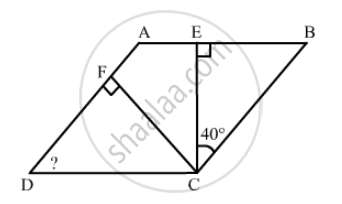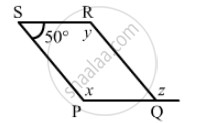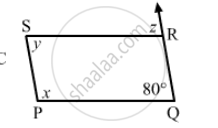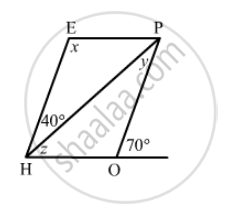Advertisements
Advertisements
प्रश्न
Find the angles marked with a question mark shown in Fig. 17.27

उत्तर
\[\text{ In } \bigtriangleup CEB: \]
\[\angle ECB + \angle CBE + \angle BEC = 180° (\text{ angle sum property of a triangle })\]
\[40° + 90° + \angle EBC = 180° \]
\[ \therefore \angle EBC = 50° \]
\[\text{ Also }, \angle EBC = \angle ADC = 50° \left( \text{ opposite angle of a parallelogram } \right)\]
\[\text{ In } \bigtriangleup FDC: \]
\[\angle FDC + \angle DCF + \angle CFD = 180° \]
\[50° + 90° + \angle DCF = 180° \]
\[ \therefore \angle DCF = 40° \]
\[\text{ Now }, \angle BCE + \angle ECF + \angle FCD + \angle FDC = 180° (\text{ in a parallelogram, the sum of alternate angles is } 180° )\]
\[50° + 40° + \angle ECF + 40° = 180° \]
\[\angle ECF = 180° - 50° + 40° - 40° = 50° \]
APPEARS IN
संबंधित प्रश्न
The following figure is parallelogram. Find the degree values of the unknown x, y, z.

The following figure is parallelogram. Find the degree values of the unknown x, y, z.

In the adjacent figure HOPE is a parallelogram. Find the angle measures x,y and z. State the geometrical truths you use to find them.

Which of the following statement is true for a rhombus?
It has only two pairs of equal sides.
Which of the following statement is true for a rhombus?
Its diagonals bisect each other at right angles.
Which of the following statement is true for a rhombus?
It is a parallelogram.
Which of the following statement is true for a rhombus?
It is a quadrilateral.
Draw a rhombus, having each side of length 3.5 cm and one of the angles as 40°.
Diagonals PR and QS of a rhombus PQRS are 20 cm and 48 cm respectively. Find the length of side PQ.
A quadrilateral whose all sides are equal, opposite angles are equal and the diagonals bisect each other at right angles is a ______.
